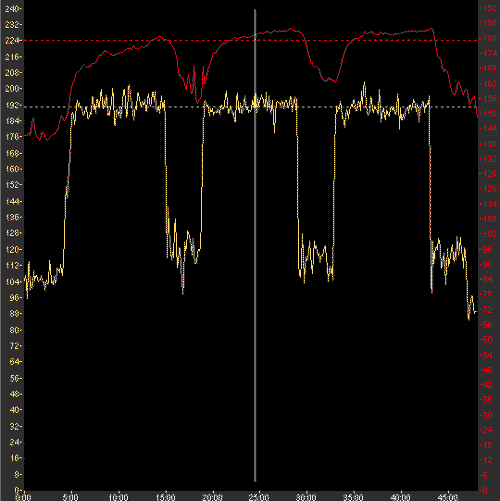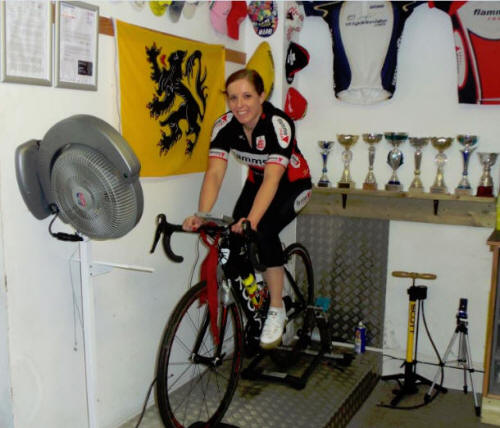FAQ ~ Ignore The Heart Numbers!

A Tempo Ten session performed by a very light, elite, lady rider
remember power numbers mean nothing if you don't know the weight of
the rider...
I don't have a power meter, so can you tell me the
heart rates I should be riding to in my Tempo Ten and Base Build
sessions?
Alan Brown ~ Malta
Now this is one I get asked an awful, awful lot. I just happened to pick this rider at random, as it was the latest one to come in.
For those that have already read the Ignore Power Numbers FAQsheet, you will see I've used exactly the same session graphic, as it explains in perfect detail exactly why we can't use heart rates for our sessions.
It's A Heart Ache
 Nothing but a heart ache, hit's you when you're too late, hits you when your down. (All
the men of a certain age are now singing along...)
Nothing but a heart ache, hit's you when you're too late, hits you when your down. (All
the men of a certain age are now singing along...)
Anyone that knows me, knows that I have an "interesting" heart rate. I won't bore you with it now, but my resting is around 48-50 bpm, my max is up around 230+. Always has been, always will be. As long as it beats, I'm happy.
I'm sure yours is more "normal" and will react in a relatively known predictable response, for a known predictable input. But that doesn't mean we can allocate heart rates for sessions, because unfortunately, life isn't that simple. Here's why...
Cause & Effect Latency
Power output is an instant response to a known input. If we
know how hard you are pressing on the pedals (torque), how fast they
are moving (cadence), and how long the lever (crank arm) is, we can
immediately define your power output. You either are, or are
not, doing 200 watts.
The heart is a whole different ball game. You cannot, with any level of accuracy whatsoever, predict a heart rate.

As you can see from the Tempo Ten interval graphic above, the average power for each interval is bang on the yellow dotted line for all three efforts at 192 watts. The heart rate however, is anything but!
For the middle effort (our baseline) the average heart rate is 179 bpm. With the heart rate creeping just above the average HR marker (the red dotted line) four minutes in to the effort, just to the left of the white vertical line. This rider was well below average for four minutes and slightly above average for six.
When the effort started, the heart was way down at 157 bpm, as it came from a 125 watt recovery period. It ramped up to above average at four minutes, then eased up to and "above" the line for the last six minutes, maxing out at 184 bpm. The heart started twenty-six beats below average and finished five beats above.
For four minutes the heart rate average lagged behind the power average; this is known as latency; the time taken to react to a stimulus.
The instant, steady-state, power demand caused a physiological reaction to the body's requirement for more oxygen, by effecting an increase in heart rate. It just took four minutes to get the message across!
Efforts One & Three
Let's take a look at what happened before and after our baseline,
middle of the road effort, that gave us our 192 w ~ 179 bpm
averages...

During the first effort, we come from our steady, low-intensity, warm-up period and the heart is "relatively relaxed". The heart never relaxes, but that's explained elsewhere on our site.
Effort one, is again, bang on the money power wise at 192 watts. The heart rate picking up at 147 bpm to max out at 180, which is just one beat above our baseline average.
The average heart rate for this effort came out at 174 bpm, five beats below the baseline, even though the wattage was perfect. In fact the HR trace never broke the average barrier until just 30 seconds to go.
The latency for effort one, could be described, as being nine minutes and thirty seconds.

For our third and last effort, we're coming to a whole new ball game!
Just in case you forgot, the power output was perfect, 192 watts. This was a perfectly paced session from an experienced athlete that knows just how hard they could go for how long.
Starting out from 162 bpm at "second one" it quickly ramped up to be above average with, unsurprisingly, our fastest latency time of two minutes and twenty seconds! Remember, it took the first effort nine minutes thirty, to get to the same point.
It then meandered along a ridge of cumulative oxygen debt to hit a max of 184 bpm right at the last second. Our heart rate was above average for 75% of this average power effort.
Never Trust Your Heart
Only trust your heart in matters of love. For the type of sessions we do, at
the intensity level we do them, for the timeframes we do them in,
it is impossible to ascribe a heart rate figure to them. Which
is why I'm always typing, PLEASE IGNORE THE
NUMBERS!
If you're riding an endurance TT or an Iron Man event, then absolutely, find a narrow heart rate range and stick within it. But with a latency of up to eight and a half minutes in a ten minute effort, you'll be doing yourself a HUGE disservice if you take this approach.
Do the best you can, to finish the session, whatever the number is at the end, it's right! If you can't make it to the end, it's a satisfying failure, you did your best, that's all that matters.
Ride on perception, learn to feel how your body works, and if the heart zones aren't what you were expecting, well maybe you're just a rebel outlier that doesn't fit the scientists model.
You are special, embrace that thought...

To see why it's just as difficult to prescribe power numbers,
check out our companion FAQsheet...








